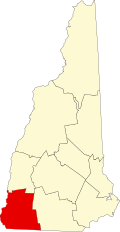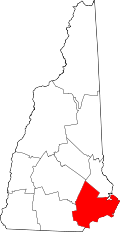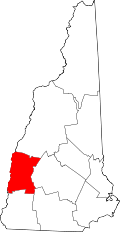List of counties in New Hampshire
There are 10 counties in the U.S. state of New Hampshire. Five of the counties were formed in 1769. This was when New Hampshire was still an English colony and not a state.
The FIPS county code is the five-digit Federal Information Processing Standard (FIPS) code which uniquely identifies counties and county equivalents in the United States. The three-digit number is unique to each individual county within a state. The code for New Hampshire is 33. The links in the column "FIPS County Code" are to the Census Bureau Info page for that county.[1]
List
| County |
FIPS code[2] | County seat[3] | Established[3] | Formed from[4] | Meaning of name[5] | Population (2020)[3] | Area[3] | Map |
|---|---|---|---|---|---|---|---|---|
| Belknap County | 001 | Laconia | 1840 | Parts of Merrimack County and Strafford County. | Jeremy Belknap (1744–1798), early New Hampshire historian. | 63,705 | 401 sq mi (1,039 km2) |

|
| Carroll County | 003 | Ossipee | 1840 | Part of Strafford County. | Charles Carroll of Carrollton (1737–1832), the last surviving signatory of the United States Declaration of Independence. | 50,107 | 934 sq mi (2,419 km2) |

|
| Cheshire County | 005 | Keene | 1769 | One of five original counties. | English county of Cheshire. | 76,458 | 708 sq mi (1,834 km2) |

|
| Coös County | 007 | Lancaster | 1803 | Part of Grafton County. | An Algonquian word meaning "small pines". | 31,268 | 1,801 sq mi (4,665 km2) |

|
| Grafton County | 009 | North Haverhill | 1769 | One of five original counties. | Augustus Henry Fitzroy, 3rd Duke of Grafton (1735–1811), a Prime Minister of Great Britain (1768–1770). | 91,118 | 1,714 sq mi (4,439 km2) |

|
| Hillsborough County | 011 | Manchester and Nashua |
1769 | One of five original counties. | Wills Hill, 1st Marquess of Downshire (1718–1793), known in America as the Earl of Hillsborough, who served as the first Secretary of State for the Colonies. | 422,937 | 876 sq mi (2,269 km2) |

|
| Merrimack County | 013 | Concord | 1823 | Parts of Hillsborough County and Rockingham County. | The Merrimack River. | 153,808 | 934 sq mi (2,419 km2) |

|
| Rockingham County | 015 | Brentwood | 1769 | One of five original counties. | Charles Watson-Wentworth, 2nd Marquess of Rockingham (1730–1782), a two-time Prime Minister of Great Britain (1765–1766, 1782). | 314,176 | 695 sq mi (1,800 km2) |

|
| Strafford County | 017 | Dover | 1769 | One of five original counties. | William Wentworth, 2nd Earl of Strafford (1626–1695), an English noble who owned colonial lands. | 130,889 | 369 sq mi (956 km2) |

|
| Sullivan County | 019 | Newport | 1827 | Part of Cheshire County. | John Sullivan (1740–1795), the third and fifth governor of New Hampshire (1786–1788, 1789–1790). | 43,063 | 537 sq mi (1,391 km2) |

|
References
- ↑ "EPA County FIPS Code Listing". US Environmental Protection Agency. Retrieved 2007-07-24.
- ↑ "EPA County FIPS Code Listing". EPA. Archived from the original on May 24, 2010. Retrieved September 8, 2008.
- ↑ 3.0 3.1 3.2 3.3 National Association of Counties. "NACo County Explorer". Retrieved 10 January 2024.
- ↑ "New Hampshire Counties". The NHGenWeb Project. Archived from the original on 2007-07-13. Retrieved 2007-07-24.
- ↑ "New Hampshire Counties". New Hampshire Almanac. Archived from the original on 2007-08-09. Retrieved 2007-07-24.
